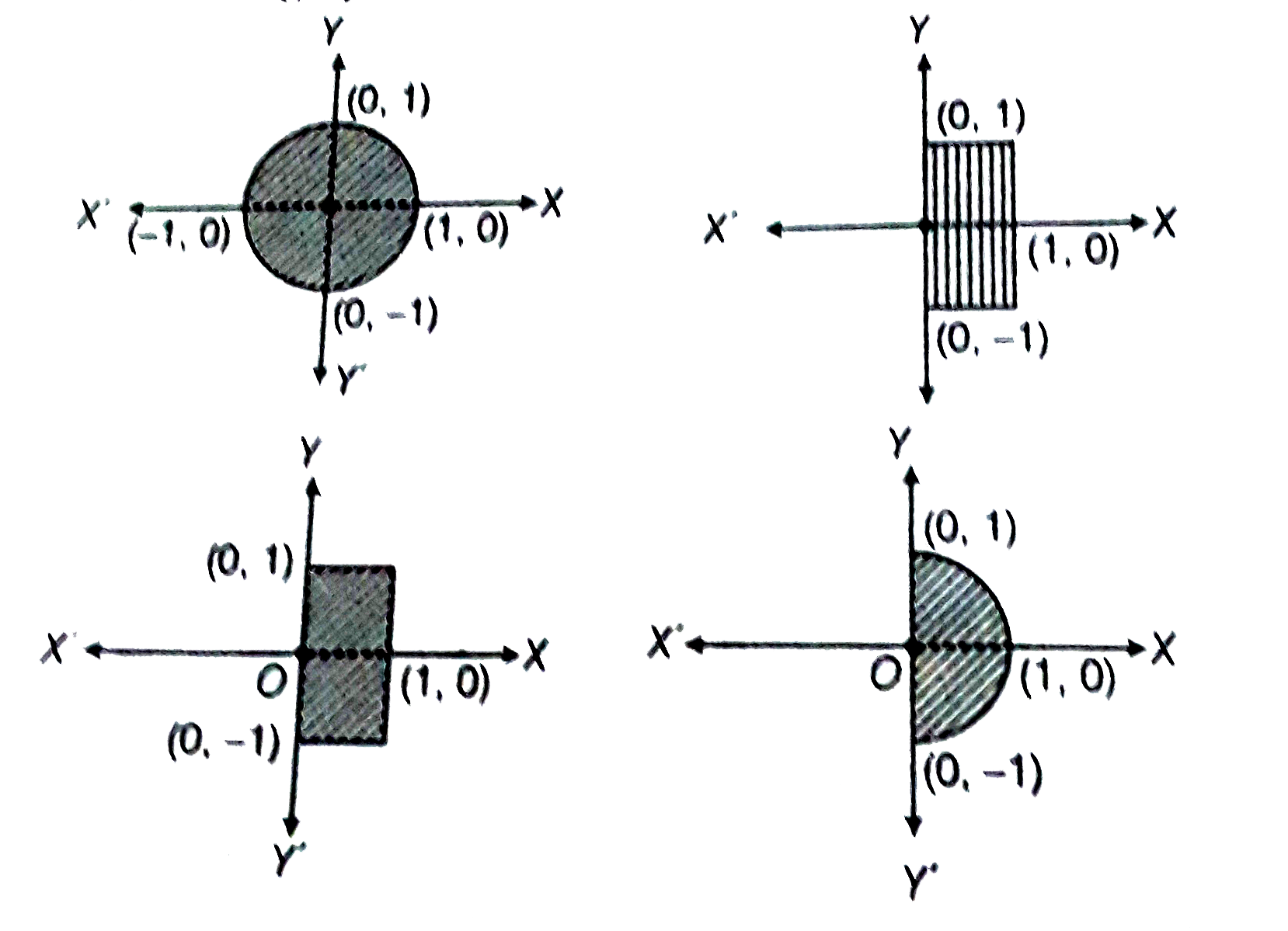A= { x: x is a natural number} B= {x: x is an even natural number} find A intersection B
The correct Answer is:X∪Y={(x,y):x2+y2≤1or0≤x≤1and−1≤y≤1}
X∩Y={(x,y):x2+y2≤1andx≥0}
X={(x,y):x2+y2≤1}
Y={(x,y):0≤x≤1−1≤y≤1}
X∪Y={(x,y):x2+y2≤1or0≤x≤1and−1≤y≤1}
X∩Y={(x,y):x2+y2≤1andx≥0}

Topper's Solved these Questions
- BOOK - ARIHANT MATHS ENGLISHCHAPTER - SETS, RELATIONS AND FUNCTIONS EXERCISE - Exercise (Questions Asked In Previous 13 Years Exam)12videos
SETS, RELATIONS AND FUNCTIONS
- BOOK - ARIHANT MATHS ENGLISHCHAPTER - SETS, RELATIONS AND FUNCTIONS EXERCISE - Exercise (Statement I And Ii Type Questions)4videos
SETS, RELATIONS AND FUNCTIONS
- BOOK - ARIHANT MATHS ENGLISHCHAPTER - SEQUENCES AND SERIESEXERCISE - Exercise (Questions Asked In Previous 13 Years Exam)38videos
SEQUENCES AND SERIES
- BOOK - ARIHANT MATHS ENGLISHCHAPTER - THE STRAIGHT LINESEXERCISE - Exercise (Questions Asked In Previous 13 Years Exam)17videos
THE STRAIGHT LINES
Similar Questions
If A= {x : x is a natural number}, B = {x : x is an even natural number}C = {x : x is an odd natural number} and D = {x : x is a prime number }, find(i) A∩B (ii) A∩C (iii) A∩D(iv) B∩C (v) B∩D (vi) C∩D
View SolutionIf A = {x : x is a natural number}, B = {x : x is an even natural number}, C = {x : x is an odd natural number} and D = {x : x is a prime number}, Find :
(i) A∩B
(ii) A∩C
(iii) A∩D
(iv) B∩C
(v) B∩D
(vi) C∩D.View SolutionFor each of the following pairs of sets , identify the disjoint and overlapping sets:
A = { x: x is a prime number ,x<8 }
B = {x: x is an even natural number , x<8} .View SolutionFind the union of each of the following pairs of sets :(i) X={1,3,5} Y={1,2,3}
(ii) A=[a,e,i,o,u} B=[a,b,c}
(iii) A= {x : x is a natural number and multiple of 3} B= {x : x is a natural number less than 6}
(iv) A= {x : x is a natural number and 1<x≤6 } B= {x : x is a natural number and 6<x<10 }
(v)A={1,2,3},B=φView SolutionTaking the set of natural numbers as the universal set, write down the complements of the following sets:
(i) {x : x is an even natural number} (ii) { x : x is an odd natural number }
(iii) {x : x is a positive multiple of 3} (iv) { x : x is a prime number }
(v) {x : x is a natural number divisible by 3 and 5}
(vi) { x : x is a perfect square } (vii) { x : x is a perfect cube}
(viii) { x : x + 5 = 8 }(ix) { x : 2x + 5 = 9}
(x) { x : x ≥ 7 }(xi) { x : x ∈ N and 2x + 1 > 10 }View SolutionExamine whether the following statements are true or false:
(i) { a, b } ⊄ { b , c, a }
(ii) { a , e } ⊂ { x : x is a vowel in the English alphabet}
(iii) { 1, 2, 3 } ⊂ { 1, 3, 5 }
(iv) { a }⊂ { a, b, c }
(v) { a }∈ { a , b, c }
(vi) { x : x is an even natural number less than 6} ⊂ { x : x is a natural number which divides 36}View SolutionSolve 24x<100, when
(i) x is a natural number.
(ii) x is an integer.View SolutionAre the following pairs of sets equal ? (i) A={x | x is prime factor of 6 } B={x |x is a solution of x2−5x+6=0}Mlbtr (ii) A={x|y is a letter in the word REPLACED}, B= { y is a letter in the word PARCELED } (iii) A= { x| x is a natural number x>1} B= {x|x is natural number x≥1}
View SolutionIf A = {x : x is an even natural number upto 20 } and B = {x : x is a factor of 18} ,find
n(A),n(B),n(A∪B)andn(A∩B)
Also varify that n(A)+n(B)=n(A∪B)+n(A∩B) .View SolutionIf n is an (a) odd natural number greater than 1, then the product of its successor and predecessor is an odd natural number (b) is an even natural number (c) can be even or odd (d) None of these
View Solution

